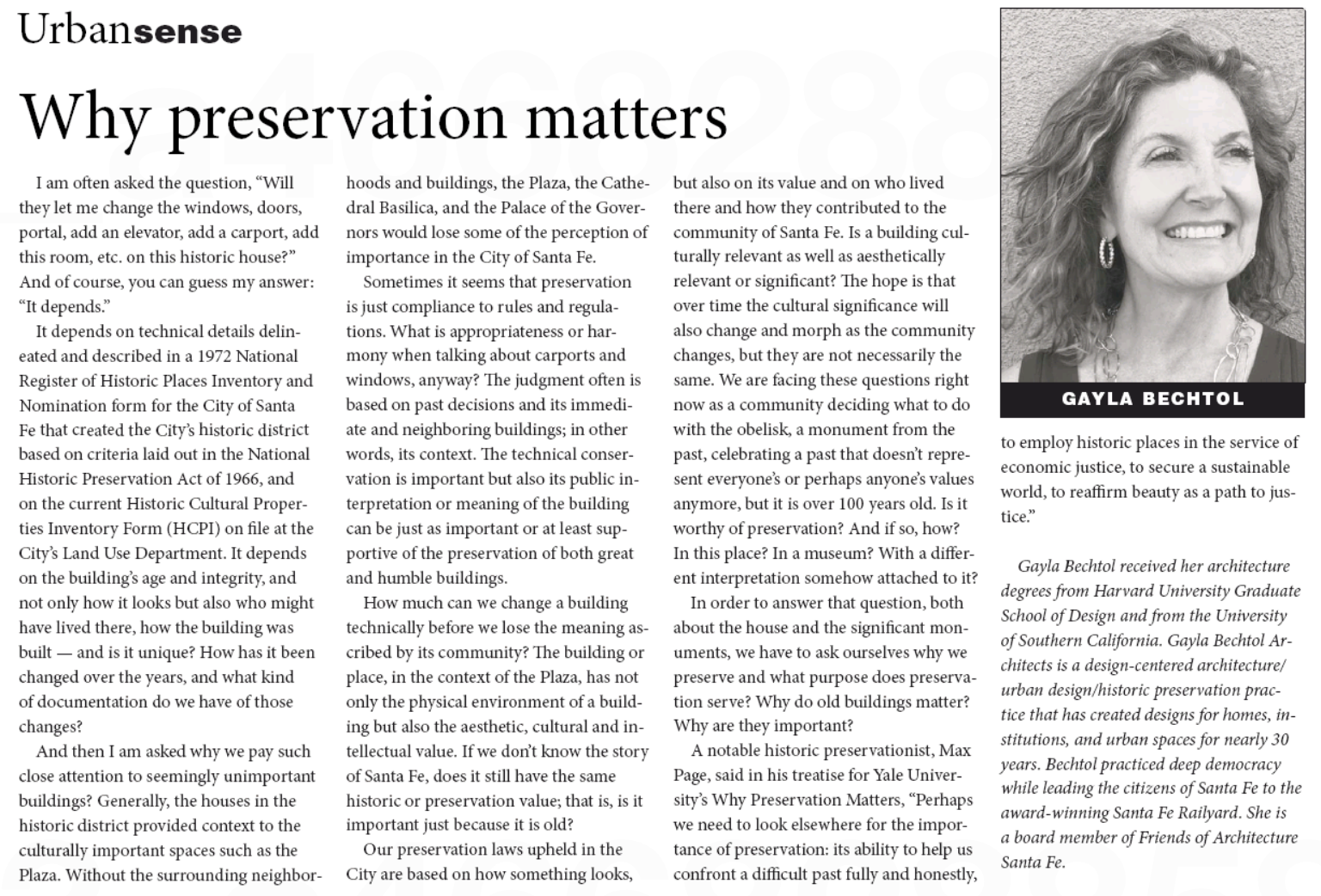Urban Sense—My New Monthly Column for The Santa Fe New Mexican
With excitement, I introduce to you my new monthly column for The Santa Fe New Mexican called “Urban Sense“. Look for it in the Home magazine on page 18. I will be discussing issues relating to Historic Preservation, Urban Design & Planning and Architecture in The City Different.
The first entry was dedicated to “Why Preservation Matters“.


Read The Article:
Often I am asked the question, “Will they let me change the windows, doors, portal, add an elevator, add a carport, add this room, etc. on this historic house?” And of course, you can guess my answer: “It depends.”
It depends on technical details delineated and described in a 1972 National Register of Historic Places Inventory and Nomination form for the City of Santa Fe that created the City’s historic district based on criteria laid out in the National Historic Preservation Act of 1966, and on the current Historic Cultural Properties Inventory Form (HCPI) on file at the City’s Land Use Department. It depends on the building’s age and integrity, and not only how it looks but also who might have lived there, how the building was built — and is it unique? How has it been changed over the years, and what kind of documentation do we have of those changes?
And then I am asked why we pay such close attention to seemingly unimportant buildings? Generally, the houses in the historic district provided context to the culturally important spaces such as the Plaza. Without the surrounding neighborhoods and buildings, the Plaza, the Cathedral Basilica, and the Palace of the Governors would lose some of the perception of importance in the City of Santa Fe.
Sometimes it seems that preservation is just compliance to rules and regulations. What is appropriateness or harmony when talking about carports and windows, anyway? The judgment often is based on past decisions and its immediate and neighboring buildings; in other words, its context. The technical conservation is important but also its public interpretation or meaning of the building can be just as important or at least supportive of the preservation of both great and humble buildings.
How much can we change a building technically before we lose the meaning ascribed by its community? The building or place, in the context of the Plaza, has not only the physical environment of a building but also the aesthetic, cultural and intellectual value. If we don’t know the story of Santa Fe, does it still have the same historic or preservation value; that is, is it important just because it is old?
Our preservation laws upheld in the City are based on how something looks, but also on its value and on who lived there and how they contributed to the community of Santa Fe. Is a building culturally relevant as well as aesthetically relevant or significant? The hope is that over time the cultural significance will also change and morph as the community changes, but they are not necessarily the same. We are facing these questions right now as a community deciding what to do with the obelisk, a monument from the past, celebrating a past that doesn’t represent everyone or perhaps anyone’s values anymore, but it is over 100 years old. Is it worthy of preservation? And if so, how? In this place? In a museum? With a different interpretation somehow attached to it?
In order to answer that question, both about the house and the significant monuments, we have to ask ourselves why we preserve and what purpose does preservation serve? Why do old buildings matter? Why are they important?
A notable historic preservationist, Max Page, said in his treatise for Yale University’s Why Preservation Matters, “Perhaps we need to look elsewhere for the importance of preservation: its ability to help us confront a difficult past fully and honestly, to employ historic places in the service of economic justice, to secure a sustainable world, to reaffirm beauty as a path to justice.”
Related Articles
No. 28 | Urban Sense: Dreaming of a Future Optimism
In the July edition of The Santa Fe New Mexican's Home Magazine,...




